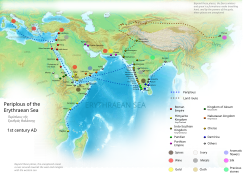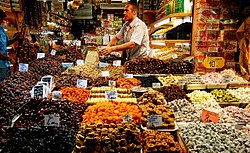Spice trade
People have been using spices for thousands of years. Often they wanted ones that didn't grow near them, so they got them from far away. One of the biggest spice routes was a route between Asia and Europe.
Only a few spices grew in Europe, so the others had to be brought from Asia. People made a route to go from Europe to Asia to buy spices. The route was very difficult and so the spices were expensive. People tried to find ways cheaper than the spice route, including going the other way around the world. This made the Age of Discovery, when they found places that they didn't know about, such as the Western Hemisphere.
Countries traded spices for gold and other things. They did this so they could get new spices or gain money and gold by selling their own. Sometimes people traded the spices because their country is running out of that certain spice.
.
Spice Trade Media
The Silk Road (red) and spice trade routes (blue).
The spice trade from India attracted the attention of the Ptolemaic dynasty, and subsequently the Roman Empire.
Austronesian proto-historic and historic maritime trade network in the Indian Ocean
Roman trade with India according to the Periplus of the Erythraean Sea, 1st century AD.
Spice Bazaar used for the spice trade during the Ottoman Empire in Istanbul
Portuguese India Armadas trade routes (blue) since Vasco da Gama 1498 travel and its rival Manila-Acapulco galleons and Spanish treasure fleets (white) established in 1568
Image of Calicut, India from Georg Braun and Frans Hogenberg's atlas Civitates orbis terrarum, 1572.
Dutch ships in Table Bay docking at the Cape Colony at the Cape of Good Hope, 1762.
Portugal claimed the Indian Ocean as its mare clausum during the Age of Discovery.









